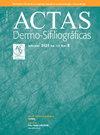皮下注射与皮下联合肌内注射肉毒杆菌毒素治疗雄激素性脱发:一项随机临床试验。
IF 2.8
Q1 DERMATOLOGY
引用次数: 0
摘要
背景:肉毒杆菌毒素A已成为雄激素性脱发(AGA)患者的一种替代治疗方法或辅助治疗方法,尽管对其安全性和有效性以及与该疾病有关的机制知之甚少。目的:评价肉毒毒素单药治疗AGA的疗效,并比较皮下注射与肌肉注射的疗效。方法:我们在墨西哥东北部的一家皮肤病诊所进行了一项为期6个月的随机对照试验,比较皮下注射与肌肉和皮下联合注射肉毒杆菌毒素对男性AGA的疗效。结果:共有15名男性,年龄27至63岁,被诊断为雄激素性脱发(AGA), Hamilton-Norwood量表分为III至V期,在纳入研究之前至少6个月未接受任何治疗,随机分配到研究开始前计算机生成的序列中。该序列对患者和研究人员都是保密的。参与者接受单次肉毒杆菌毒素治疗,皮下和肌肉注射(a组)或皮下单一治疗(B组)。每位患者注射100单位肉毒杆菌毒素。在使用Fotofinder Trichoscale®应用肉毒杆菌毒素6个月后,比较初始和随访的额部和顶部的毛发镜照片时,A组和B组的头发密度或绒毛/顶毛比均未观察到显著变化(p > 0.05),两组的额部毛发厚度均显著减少。A组前额区终末毛数明显减少(p = 0.035),而B组减少无统计学意义。枕区各项指标均无明显变化(p < 0.05)。此外,应用后6个月,两种治疗方式之间无显著差异(p < 0.05)。结论:根据我们的研究,我们没有发现任何支持使用肉毒杆菌毒素治疗AGA的结果。本文章由计算机程序翻译,如有差异,请以英文原文为准。

Subcutaneous Versus Combined Subcutaneous and Intramuscular Botulinum Toxin for Androgenetic Alopecia: A Randomized Clinical Trial
Background
Botulinum toxin A has emerged as an alternative treatment for patients who have contraindications to other therapies or as an adjuvant therapy in the treatment of androgenetic alopecia (AGA), although little is known about its safety and efficacy profile or the mechanism involved in this disease.
Objective
To evaluate the efficacy profile of botulinum toxin as monotherapy for AGA and compare subcutaneous vs subcutaneous and intramuscular application.
Methods
We conducted a 6-month, randomized, controlled trial to compare the efficacy of subcutaneous vs combined intramuscular and subcutaneous botulinum toxin application in men with AGA at a dermatology clinic in northeastern Mexico.
Results
A total of 15 men, aged 27–63 years, diagnosed with androgenetic alopecia (AGA) classified as stages III to V on the Hamilton-Norwood scale, and with no prior treatment for, at least, 6 months prior to being included in the study, were randomly allocated following a computer-generated sequence created prior to the start of the study. The sequence was blinded to both patients and investigators. Participants received a single session of botulinum toxin, administered either subcutaneously and intramuscularly (Group A) or subcutaneously as monotherapy (Group B). Each patient received 100 units of botulinum toxin. When comparing the initial and follow-up trichoscopic photographs of the frontal and vertex regions 6 months after botulinum toxin application using Fotofinder Trichoscale®, no significant changes were observed in hair density or the vellus/terminal hair ratio in either Group A or Group B (p > 0.05), and a significant reduction in hair thickness was detected in the frontal region of both groups. Terminal hair count in the frontal region decreased significantly in Group A (p = 0.035), whereas the reduction in Group B was not statistically significant. In the occipital region, none of the evaluated parameters showed significant changes (p > 0.05). Additionally, no significant differences were seen between the 2 treatment modalities 6 months after application (p > 0.05).
Conclusion
Based on our study, we did not find any supportive results for the use of botulinum toxin in the treatment of AGA.
求助全文
通过发布文献求助,成功后即可免费获取论文全文。
去求助
来源期刊

Actas dermo-sifiliograficas
DERMATOLOGY-
CiteScore
1.90
自引率
9.40%
发文量
473
审稿时长
56 weeks
期刊介绍:
Actas Dermo-Sifiliográficas, publicación Oficial de la Academia Española de Dermatología y Venereología, es una revista de prestigio consolidado. Creada en 1909, es la revista mensual más antigua editada en España.En 2006 entró en Medline, y hoy resulta imprescindible para estar al día sobre la dermatología española y mundial.
 求助内容:
求助内容: 应助结果提醒方式:
应助结果提醒方式:


